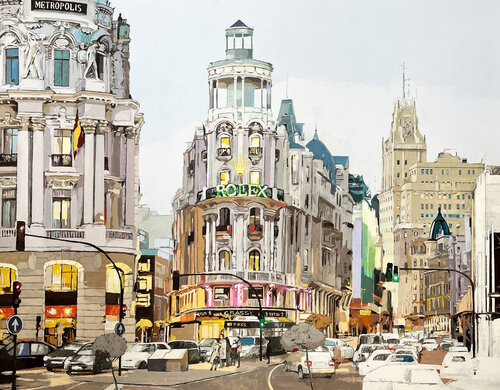Painting Lost Places from Memory: Capturing Forgotten Visions
For many professional photographers, the art of painting lost places from memory offers a unique and challenging way to explore creativity. This practice not only helps in honing one's artistic skills but also provides a medium to capture and preserve the essence of places that are no longer accessible. In this article, we delve into the intriguing process of recreating lost places through painting, offering insights and techniques that can enrich your photographic journey.

The Intriguing Art of Memory-Based Painting
The concept of painting lost places from memory is deeply fascinating. It requires the artist to recall details, emotions, and the atmosphere of a place that no longer exists or is inaccessible. This method of painting is not only an artistic challenge but also a mental exercise in visual memory. For photographers, this can be an excellent way to develop a keen eye for detail and a deeper understanding of composition.
Memory-based painting demands a strong connection to the subject. It's not just about reproducing a physical location; it's about capturing the essence and spirit of the place. This technique is particularly beneficial for photographers who aim to convey emotion and narrative through their work. By practicing this form of art, photographers can enhance their ability to tell stories through images.
Techniques for Painting from Memory
To successfully engage in painting lost places from memory, one must develop certain techniques and practices. Here are some strategies to consider:
Developing Visual Memory
One of the most crucial skills for painting from memory is the ability to remember visual details. This involves training the mind to notice and retain intricate details such as light, color, texture, and spatial relationships. Regular practice in sketching and drawing from observation can significantly enhance your visual memory.
Journaling and Sketching
Keeping a journal or sketchbook is an invaluable tool for artists. By regularly documenting thoughts, ideas, and quick sketches, photographers can create a personal library of visual references. This practice not only aids memory but also provides a source of inspiration for future projects. Consider exploring [this guide](https://www.domestika.org/en/blog/8767-10-artists-to-inspire-your-travel-illustration-journal) to enhance your journaling techniques.
Emotional Connection
Painting lost places is as much about emotional resonance as it is about visual accuracy. To convey the true essence of a place, it's essential to tap into the emotions associated with it. This emotional connection can transform a painting from a mere representation to an evocative piece of art.
Incorporating Photography with Memory Painting
Combining photography with memory painting can lead to stunning and unique artwork. Photographers can use their skills to capture the initial impression of a place, which can then be used as a reference for painting from memory. This blend of mediums allows for a dynamic exploration of artistic expression.
For example, consider photographing a location before it undergoes change or is demolished. This photographic record can serve as a foundation for later paintings. By doing so, photographers can create a visual narrative that spans time and preserves the memory of lost places.
Why Photographers Should Explore Memory Painting
For professional photographers, venturing into the realm of painting lost places from memory offers numerous benefits. Not only does it expand creative horizons, but it also enhances technical skills and artistic vision. This practice encourages photographers to think beyond the lens and explore new ways of storytelling.
Additionally, memory painting can lead to the creation of unique art pieces that stand out in a portfolio. By showcasing a combination of photography and painting, photographers can attract a wider audience and offer a diverse range of work. This approach can be particularly appealing to clients looking for bespoke art that captures the essence of a place.
The Impact of Memory Painting on Photography
Engaging in the practice of painting lost places from memory can have a profound impact on a photographer's work. It encourages a deeper understanding of composition, color theory, and storytelling. Moreover, it fosters a more intuitive approach to capturing images, leading to more authentic and impactful photographs.
As photographers become more adept at recalling and recreating lost places, they develop a unique artistic voice that distinguishes their work. This voice is not only rooted in technical skill but also in a profound appreciation for the transient nature of places and moments.
Conclusion
The art of painting lost places from memory offers a rich and rewarding journey for professional photographers. By embracing this practice, photographers can enhance their creative skills, expand their artistic repertoire, and create powerful visual narratives. Whether you're an experienced artist or a curious novice, delving into memory painting can open new doors to artistic expression and personal growth.
For more insights into integrating various art forms into your photography practice, check out [Photo4Art's blog](https://photo4art.com/blogs/our-all-posts/hanging-big-wall-art) for inspiration and tips on creating cohesive art displays.

FAQs
What is the benefit of painting lost places from memory for photographers?
Painting lost places from memory helps photographers develop a stronger visual memory and emotional connection to their subjects, enhancing their storytelling capabilities through their photographs.
How can I improve my visual memory for painting?
Improving visual memory involves regular practice in sketching and drawing from observation, as well as keeping a detailed journal or sketchbook to document visual details and ideas.
Can photography and memory painting be combined effectively?
Yes, combining photography with memory painting can result in unique and compelling artwork, allowing photographers to explore new artistic expressions and create a rich visual narrative.

